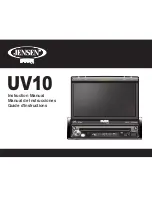
Web: www.tinker-rasor.com
E-mail: [email protected]
– 2 –
P
RODUCT
I
NSTRUCTIONS
ASSEMBLY INSTRUCTIONS
(ON HANDLE) OPERATION
STEP ONE:
Assemble instrument as illustrated.
STEP TWO:
Read condensed instructions on RECEIVER
panel and page 3 of operating instructions.
Make adjustments accordingly.
STEP THREE:
When crossing a metal pipe or conduit at right angles you will note an increased tone and meter reading.
For best results the pipe should be crossed from each side and position marked where the indication is the
strongest. The true location of the buried pipe is exactly between the two marks. If the indication is too
broad, reduce the sensitivity to narrow the width of the indication.
GENERAL INFORMATION
These instructions have been prepared to help you obtain the maximum usefulness and results from your
DETECTRON PIPE & CABLE LOCATOR. It would be extremely difficult, if not impossible, to describe
each and every step in detail for all applications because of the variations of environmental conditions and
operator skills. With the aid of suggested procedures outlined in this manual and a brief familiarization
period, the operator can expect to obtain excellent results.
THEORY OF OPERATION
DETECTRON PIPE & CABLE LOCATORS
provide, in practical form, an electronic instrument for
locating and accurately “pinpointing” concealed metal objects such as metallic pipe, cables, conduit, etc.
and determining their true course.
The locator consists of two basic units: a directional radio frequency TRANSMITTER and a RECEIVER.
The TRANSMITTER generates an electromagnetic field which surrounds the buried metallic object or, in
the case of a pipe, travels along it. The locator may be operated INDUCTIVELY coupled through air
and/or ground to the concealed pipe or other metal object. A direct wire connection between the
TRANSMITTER and pipe may be used. The RECEIVER detects and traces the electromagnetic field. By
this means, the exact location and orientation of the pipe can be determined. A thorough understanding of
the theory of operations is extremely valuable. The operator should be aware of the fact that unusual
changes in soil conductivity or random metal objects can cause misleading indications
METHODS OF OPERATION
INDUCTIVE OPERATION (WITH HANDLE)
The location of unknown metal pipe, cable and conduits can best be accomplished with the RECEIVER
and TRANSMITTER coupled together by means of the provided carrying handle.
DIVISION OF TINKER & RASOR
2828 FM 758, NEW BRAUNFELS, TX 78130 TEL: (830) 253-5621
www.detectron.com



























